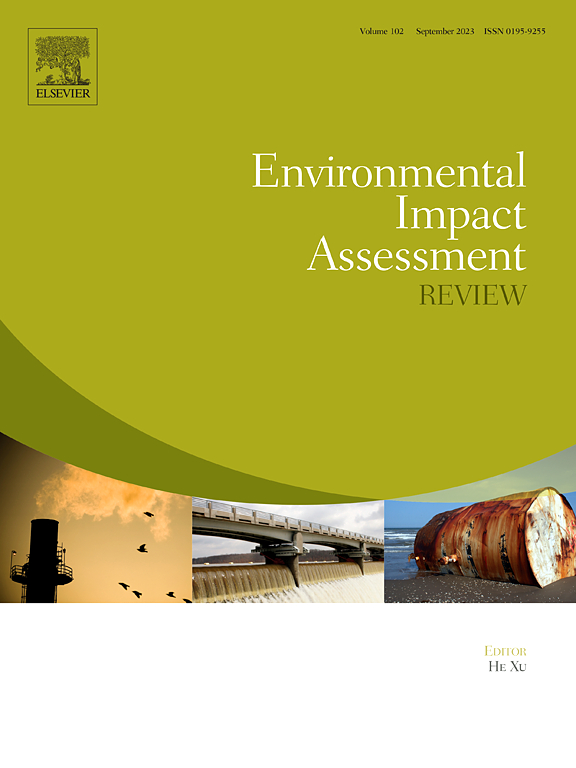超临界燃煤电厂燃烧后碳捕集技术的全生命周期环境影响与经济分析
IF 9.8
1区 社会学
Q1 ENVIRONMENTAL STUDIES
引用次数: 0
摘要
燃煤电厂仍然是全球二氧化碳排放的主要来源,迫切需要部署碳捕获技术来减轻气候影响。本研究通过电厂层面的生命周期环境和经济评估,评估了四种燃烧后碳捕获(PCC)系统——基于单乙醇胺(MEA)的化学吸收、基于氨的吸收、膜分离和钙环(CaL),以评估各种技术在减排和成本效益之间的权衡。结果表明,与基线植物相比,PCC技术使全球变暖潜势和酸化潜势分别降低了61.3 ~ 77.6%和66.2 ~ 83.5%。其他环境影响类别均有不同程度的增加,特别是化石非生物耗竭潜力(增加3.8 ~ 49.3%)和海洋水生生态毒性潜力(增加10.8 ~ 66.8%),占总环境影响的80%以上。与基线工厂相比,PCC工厂的总生命周期成本增加了35 - 66%,其中外部成本下降了66.5 - 78.1%,内部成本增加了62.6 - 100.9%。除非生物耗竭潜势要素外,CaL电厂对环境影响最小,外部成本降低幅度最大(78.1%),内部成本增加幅度最大(77.7%)。膜分离PCC装置的总生命周期成本最低,外部成本降低了70.0%,而内部成本仅增加了62.6%。因此,我们建议将膜分离作为一种结合了环境和经济因素的PCC技术。研究结果为企业选择和部署碳捕集技术提供了参考。本文章由计算机程序翻译,如有差异,请以英文原文为准。

Life cycle environmental impact and economic analysis of post-combustion carbon capture technologies in supercritical coal-fired power plants
Coal-fired power plants remain a major contributor to global CO₂ emissions, necessitating the urgent deployment of carbon capture technologies to mitigate climate impacts. This study evaluated four post-combustion carbon capture (PCC) systems – monoethanolamine (MEA)-based chemical absorption, ammonia-based absorption, membrane separation, and calcium looping (CaL) – through life cycle environmental and economic assessments at the power plant level, to assess the trade-offs between emission reductions and cost-effectiveness across technologies. The results showed that, compared with the baseline plant, PCC technologies reduced the global warming potential and acidification potential by 61.3–77.6 % and 66.2–83.5 %, respectively. Other environmental impact categories increased to varying degrees, in particular Abiotic Depletion Potential fossil (by 3.8–49.3 %) and the marine aquatic ecotoxicity potential (by 10.8–66.8 %), which account for more than 80 % of the total environmental impact. The total life cycle costs of PCC plants increased by 35–66 % compared with that of the baseline plant, with external costs decreasing by 66.5–78.1 % and internal costs increasing by 62.6–100.9 %. The CaL power plant had the lowest environmental impact of the PCC plants except for Abiotic Depletion Potential elements, which had the largest reduction in external costs (78.1 %) and an increase in internal costs (77.7 %). Membrane separation PCC plants had the lowest total life cycle cost, reducing external costs by 70.0 %, while increasing internal costs by only 62.6 % compared. Thus, we recommend deploying membrane separation as a PCC technology, which combines environmental and economic factors. Our findings provide a reference for companies to select and deploy carbon capture technology.
求助全文
通过发布文献求助,成功后即可免费获取论文全文。
去求助
来源期刊

Environmental Impact Assessment Review
ENVIRONMENTAL STUDIES-
CiteScore
12.60
自引率
10.10%
发文量
200
审稿时长
33 days
期刊介绍:
Environmental Impact Assessment Review is an interdisciplinary journal that serves a global audience of practitioners, policymakers, and academics involved in assessing the environmental impact of policies, projects, processes, and products. The journal focuses on innovative theory and practice in environmental impact assessment (EIA). Papers are expected to present innovative ideas, be topical, and coherent. The journal emphasizes concepts, methods, techniques, approaches, and systems related to EIA theory and practice.
 求助内容:
求助内容: 应助结果提醒方式:
应助结果提醒方式:


